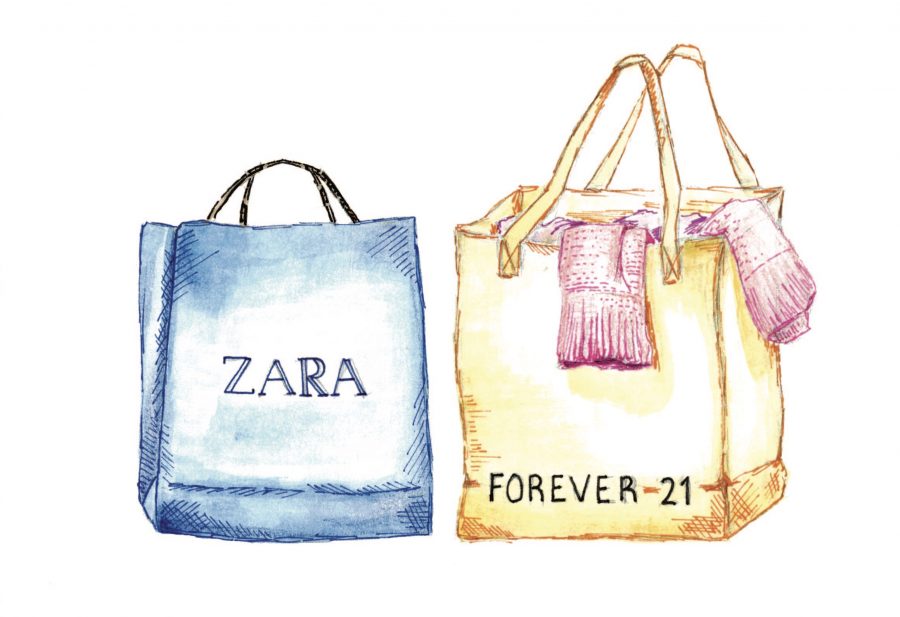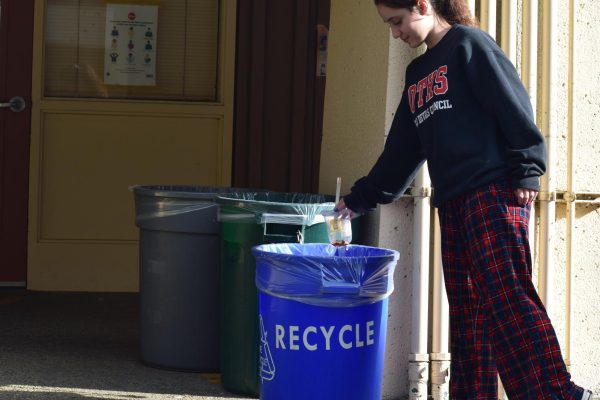Clothing Consciousness
Fashion industry’s impacts on the environment and how to choose clothing to help the problem

Flipping through the racks of clothing at a department store, it may be challenging to find clothes that match both your budget and your beliefs. Picking where to purchase your clothing can be a difficult but important decision. Most often, the quality of your clothes correlates with how expensive it is. Nowadays, it seems as though many more people rely on fast and cheap garments that come from stores like Forever 21 to keep up with the constantly changing fashion trends.
Fast fashion propelled its way into the fashion world in the 1990s and is simply defined as inexpensive clothing produced rapidly by mass-market retailers to accommodate the latest trends. For those on a budget, namely teens, these fast fashion stores Zara and Forever 21 can be alluring for several reasons.
Stores like Zara, H&M and Forever 21 are able to supply affordable trendy clothing while bringing it to market quickly. These stores provide one-time use clothing, appropriate for certain events. Searching for a trendy piece replicating the dress worn by Kim Kardashian? Look no further! Forever 21 has got you covered.
These clothes may seem like a sweet bargain; however, the low price often cloaks the negative impacts that they can have on the environment. Since the majority of fast fashion is made of cheap material, they wear easily and are subsequently thrown out, adding to landfills and dumps.
“If these clothes are not meant to last, they’re going to end up in the garbage which could be a landfill, and are sometimes incinerated, which is really bad for our air.”
– AP Environmental Science teacher Alicia Szebert
“In the goods industry, not only is there extraction, production, processing, you also have the waste aspect,” AP Environmental Science teacher Alicia Szebert says. “If these clothes are not meant to last, they’re going to end up in the garbage which could be a landfill, and are sometimes incinerated, which is really bad for our air.”
Ideally, used clothing could be in fair condition so another person could wear it, but because they are not made to last, the chance of that happening is pretty small. In addition, the deregulation of production also adds to the multitude of pollutants found all over the world.
According to the Wall Street Journal, when washed, these fast fashion items release more than half-million tons of minuscule microfibers into the ocean each year. Because of their size and their deregulation by water treatment services, these microfibers are able to make their way into the bodies of marine life, poisoning them and sometimes even making their way into our own bodies when we consume the animals.

Another way fast fashion clothing hurts the environment is the materials incorporated into it. One of the harmful materials used in the mass production of this clothing is polyester. Polyester produces two or three times the amount of carbon emissions compared to the production of cotton, worsening the air quality according to the World Resources Institute. Even worse, it doesn’t break down when it’s in the ocean–instead, it adds to the rather high level of plastic currently in the ocean.
Lastly, the fast industry consumes lots of water to produce these products. To produce a cotton shirt, it takes about 700 gallons of water according to WorldWildLife.org. This shirt is made of cotton, an ingredient heavily dependent upon water. and can heavily drain a country’ water availability.
Rather than using these damaging materials, Szebert suggests that clothing companies should use organic materials such as wool and silk, which are better for the environment and last longer.
“They completely decompose naturally, so the waste isn’t that big of an issue,” Szebert says.
Despite the current negative environmental impacts, fast fashion companies are making efforts to discontinue these problems. One way is by encouraging consumers to recycle clothes. Stores like H&M, for example, have set up small recycling bins inside their locations available for customers to toss in their old clothes previously bought from the store. In exchange, customers will receive a $5 voucher, acting as an incentive to be more environmentally cautious. Although this gesture is honorable, it doesn’t entirely mitigate the impact H&M has on the environment as it offers consumers an incentive to keep buying their clothing.
As unease about climate change grows, an influx of sustainable clothing stores such as Everlane, Patagonia and Reformation has started to appear and grab the public’s attention. According to Reformation, up to two-thirds of the environmental impact of the fashion industry occurs before the clothes are actually made.

Reformation’s policy indicates that the most crucial part in ensuring environmental sustainability is the fabric that is used and the process in which the products are created. Reformation states that their standards take into consideration water input, energy input, land-use, eco-toxicity, greenhouse gas emissions, human toxicity and more.
However, these eco-friendly clothes, while they may be appealing, come at a high cost. A typical dress found at Reformation averages about $200, which is far beyond the price range for many American teens.
One solution that has been growing in popularity is thrifting. Teens flock to these stores because the clothes are often a good bargain as they are usually in relatively good condition and are at a low price. They also give the clothes a second life, thus being environmentally-friendly.
By buying second hand, thrifting expands the lifespan of clothes and keeps resources invested in all of the clothes. Senior Isabelle Armstrong says she thrifts because of the positive impact on the environment it brings and unique cheap items that can be found.
“I think there is something really beautiful to know that you’re continuing a cycle of sustainability by not engaging in fast fashion”
– Senior Isabelle Armstrong
“I think there is something really beautiful to know that you’re continuing a cycle of sustainability by not engaging in fast fashion,” Armstrong says.
A more unique way consumers can shop sustainably is to avoid fashion trends. Although it may seem absurd to high schoolers, it is important for people to avoid buying too much clothing in order to reduce the volume of clothes being thrown out.
“You would be sacrificing some of the trendiness to spend a little bit more money on a better-made garment that’s a more classic piece,” Szebert says.
To avoid the environmental harms brought to us by the fashion industry, consider Szebert’s lasting advice the next time you visit the mall.
“Buying better-made pieces and thinking about the company you’re buying from, where it’s made, what it’s made of,” Szebert says.
Written by Jacquelyn Lai and Gwyneth Wong.











rinoagreengirl
Apr 16, 2020 at 1:03 am
Cool post! Great that you are making people aware of fast fashion and its consequences.